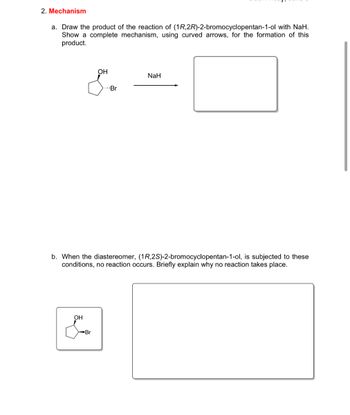
Chemistry
10th Edition
ISBN: 9781305957404
Author: Steven S. Zumdahl, Susan A. Zumdahl, Donald J. DeCoste
Publisher: Cengage Learning
expand_more
expand_more
format_list_bulleted
Concept explainers
Question

Transcribed Image Text:2. Mechanism
a. Draw the product of the reaction of (1R,2R)-2-bromocyclopentan-1-ol with NaH.
Show a complete mechanism, using curved arrows, for the formation of this
product.
OH
NaH
Br
b. When the diastereomer, (1R,2S)-2-bromocyclopentan-1-ol, is subjected to these
conditions, no reaction occurs. Briefly explain why no reaction takes place.
OH
Br
Expert Solution
This question has been solved!
Explore an expertly crafted, step-by-step solution for a thorough understanding of key concepts.
This is a popular solution
Trending nowThis is a popular solution!
Step by stepSolved in 3 steps with 1 images

Knowledge Booster
Learn more about
Need a deep-dive on the concept behind this application? Look no further. Learn more about this topic, chemistry and related others by exploring similar questions and additional content below.Similar questions
- One of the two diastereomers shown below reacts with potassium tertbutoxide significantly faster than then the other. Which one is it? Provide an explanation and predict the product of the fast reaction.arrow_forwardHCI H₂C CH3 H₂C CH3 CH3 H₂C CH3 CI Treating 1,3-pentadiene with one mole of HCI give a mixture of five isomeric products. Draw curved arrows to show the movement of electrons in this step of the reaction mechanism. Arrow-pushing Instructions AC XT H CI-H - :C H₂C CH3 H₂C H₂C CH3 H3C CH3 CH3arrow_forward8. Draw a detailed mechanism for the following reaction. Remember to use the correct arrow conventions for indicating electron flow and to keep track of formal charges. You do not need to indicate stereochemistry with dashes and wedges. Indicate initiation, propagation, and termination steps. CI Br-Cl hv Brarrow_forward
- 4. Write the mechanism of the following reaction. Use curved arrows to show the movement of electrons in each step. Draw the bromonium ion intermediate emphasizing the major position of positive charge. Draw and write "cis" or "trans" of the high priority groups in the product for full credit + Br-OH, water, NaOH Hi CH3arrow_forward5. Subjection of 1-bromo-1-methylcyclopentane to the hydrolytic conditions shown leads to a mixture of products. Br -CH3 H₂O heat -CH3 OH -CH3 =CH₂ + H3O+ + Br A B с a. Which alkene do you expect to be most abundant in the product mixture? b. Provide a stepwise mechanism to explain how the alkene labeled C is formed. c. The reaction above is shown with hydronium ion (pK₂~-1.7) and bromide as products rather than HBr (pKa ~ -9). Use acid-base concepts to explain why HBr does not exist when there is an abundance of water.arrow_forwardPropose a structure for the undesired product and explain why this product is formed under these conditions.arrow_forward
- 2.a. Give the mechanism and product(s) for the reaction below. Be sure to show the initiation step(s). 2.b. How are the products related? Clearly indicate stereochemistry. + HBr HOOHarrow_forwardPropose a mechanism for this transformation. Add any remaining curved arrow(s) to complete step 1 of the mechanism. Modify the given drawing of the product as needed to show the intermediate that is formed in this step. H. P HÖ: HO он + 1-ÖH; F CI + Br + ----arrow_forward5.arrow_forward
- 6. Methylcyclopentanol on treatment with HBr gives 1-bromo-1-methylcyclopentane as a major product. Show a detailed mechanism to explain your answer . CH3 H3C Br HBr HO- -H20 2-methylcyclopentanol 1-bromo-1-methylcyclopentane CS Scanned with CamScannerarrow_forwardwhat product would you expect from the SN1 reaction of (S)-3-methyloctan-3-ol[(S)-3-hydroxy-3-methyloctane] with HBr? Show the stereochemistry of both starting materail and product.arrow_forwardHow many possible regioisomers are possible from the following E1 reaction? How many of these regioisomers have corresponding stereoisomers (ie. E/Z isomers)? Explain. Br H₂O, heatarrow_forward
arrow_back_ios
SEE MORE QUESTIONS
arrow_forward_ios
Recommended textbooks for you
 ChemistryChemistryISBN:9781305957404Author:Steven S. Zumdahl, Susan A. Zumdahl, Donald J. DeCostePublisher:Cengage Learning
ChemistryChemistryISBN:9781305957404Author:Steven S. Zumdahl, Susan A. Zumdahl, Donald J. DeCostePublisher:Cengage Learning ChemistryChemistryISBN:9781259911156Author:Raymond Chang Dr., Jason Overby ProfessorPublisher:McGraw-Hill Education
ChemistryChemistryISBN:9781259911156Author:Raymond Chang Dr., Jason Overby ProfessorPublisher:McGraw-Hill Education Principles of Instrumental AnalysisChemistryISBN:9781305577213Author:Douglas A. Skoog, F. James Holler, Stanley R. CrouchPublisher:Cengage Learning
Principles of Instrumental AnalysisChemistryISBN:9781305577213Author:Douglas A. Skoog, F. James Holler, Stanley R. CrouchPublisher:Cengage Learning Organic ChemistryChemistryISBN:9780078021558Author:Janice Gorzynski Smith Dr.Publisher:McGraw-Hill Education
Organic ChemistryChemistryISBN:9780078021558Author:Janice Gorzynski Smith Dr.Publisher:McGraw-Hill Education Chemistry: Principles and ReactionsChemistryISBN:9781305079373Author:William L. Masterton, Cecile N. HurleyPublisher:Cengage Learning
Chemistry: Principles and ReactionsChemistryISBN:9781305079373Author:William L. Masterton, Cecile N. HurleyPublisher:Cengage Learning Elementary Principles of Chemical Processes, Bind...ChemistryISBN:9781118431221Author:Richard M. Felder, Ronald W. Rousseau, Lisa G. BullardPublisher:WILEY
Elementary Principles of Chemical Processes, Bind...ChemistryISBN:9781118431221Author:Richard M. Felder, Ronald W. Rousseau, Lisa G. BullardPublisher:WILEY

Chemistry
Chemistry
ISBN:9781305957404
Author:Steven S. Zumdahl, Susan A. Zumdahl, Donald J. DeCoste
Publisher:Cengage Learning

Chemistry
Chemistry
ISBN:9781259911156
Author:Raymond Chang Dr., Jason Overby Professor
Publisher:McGraw-Hill Education

Principles of Instrumental Analysis
Chemistry
ISBN:9781305577213
Author:Douglas A. Skoog, F. James Holler, Stanley R. Crouch
Publisher:Cengage Learning

Organic Chemistry
Chemistry
ISBN:9780078021558
Author:Janice Gorzynski Smith Dr.
Publisher:McGraw-Hill Education

Chemistry: Principles and Reactions
Chemistry
ISBN:9781305079373
Author:William L. Masterton, Cecile N. Hurley
Publisher:Cengage Learning

Elementary Principles of Chemical Processes, Bind...
Chemistry
ISBN:9781118431221
Author:Richard M. Felder, Ronald W. Rousseau, Lisa G. Bullard
Publisher:WILEY